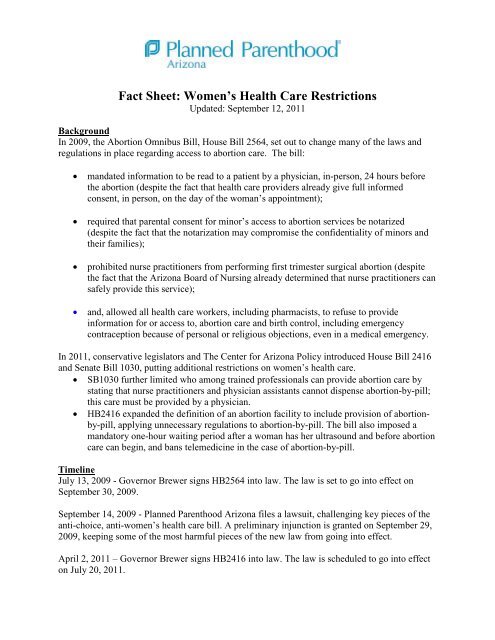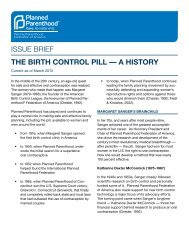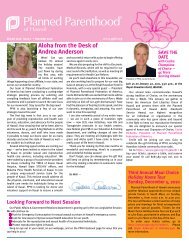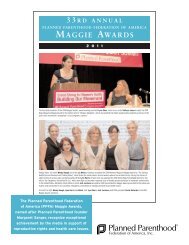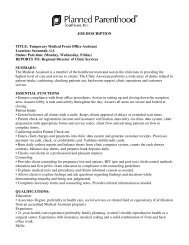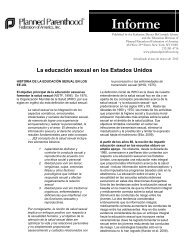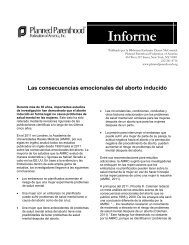Fact Sheet - Planned Parenthood
Fact Sheet - Planned Parenthood
Fact Sheet - Planned Parenthood
You also want an ePaper? Increase the reach of your titles
YUMPU automatically turns print PDFs into web optimized ePapers that Google loves.
<strong>Fact</strong> <strong>Sheet</strong>: Women’s Health Care Restrictions<br />
Updated: September 12, 2011<br />
Background<br />
In 2009, the Abortion Omnibus Bill, House Bill 2564, set out to change many of the laws and<br />
regulations in place regarding access to abortion care. The bill:<br />
• mandated information to be read to a patient by a physician, in-person, 24 hours before<br />
the abortion (despite the fact that health care providers already give full informed<br />
consent, in person, on the day of the woman’s appointment);<br />
• required that parental consent for minor’s access to abortion services be notarized<br />
(despite the fact that the notarization may compromise the confidentiality of minors and<br />
their families);<br />
• prohibited nurse practitioners from performing first trimester surgical abortion (despite<br />
the fact that the Arizona Board of Nursing already determined that nurse practitioners can<br />
safely provide this service);<br />
• and, allowed all health care workers, including pharmacists, to refuse to provide<br />
information for or access to, abortion care and birth control, including emergency<br />
contraception because of personal or religious objections, even in a medical emergency.<br />
In 2011, conservative legislators and The Center for Arizona Policy introduced House Bill 2416<br />
and Senate Bill 1030, putting additional restrictions on women’s health care.<br />
• SB1030 further limited who among trained professionals can provide abortion care by<br />
stating that nurse practitioners and physician assistants cannot dispense abortion-by-pill;<br />
this care must be provided by a physician.<br />
• HB2416 expanded the definition of an abortion facility to include provision of abortionby-pill,<br />
applying unnecessary regulations to abortion-by-pill. The bill also imposed a<br />
mandatory one-hour waiting period after a woman has her ultrasound and before abortion<br />
care can begin, and bans telemedicine in the case of abortion-by-pill.<br />
Timeline<br />
July 13, 2009 - Governor Brewer signs HB2564 into law. The law is set to go into effect on<br />
September 30, 2009.<br />
September 14, 2009 - <strong>Planned</strong> <strong>Parenthood</strong> Arizona files a lawsuit, challenging key pieces of the<br />
anti-choice, anti-women’s health care bill. A preliminary injunction is granted on September 29,<br />
2009, keeping some of the most harmful pieces of the new law from going into effect.<br />
April 2, 2011 – Governor Brewer signs HB2416 into law. The law is scheduled to go into effect<br />
on July 20, 2011.
June 14, 2011 - The Court of Appeals hears arguments on whether the preliminary injunction<br />
should remain in effect while the lawsuit continues over the provisions set in the 2009 law.<br />
June 29, 2011 – <strong>Planned</strong> <strong>Parenthood</strong> Arizona files a lawsuit challenging the constitutionality of<br />
the provisions set in HB2416 and SB1030.<br />
July 6, 2011 – The challenged provisions from HB2416 and SB1030 are stayed and are not to go<br />
into effect until after a hearing, scheduled for September 12.<br />
August 11, 2011 - The Court of Appeals remands the preliminary injunction for HB2564.<br />
August 16, 2011 - <strong>Planned</strong> <strong>Parenthood</strong> Arizona withdraws its request for a preliminary<br />
injunction related to HB2416 and SB1030<br />
August 18, 2011 – The enjoined provisions from HB2416 and SB1030 are put into place at<br />
<strong>Planned</strong> <strong>Parenthood</strong> Arizona’s health centers. With limited trained physicians available to<br />
provide services, three of the original ten health centers that provided abortion (by-pill or inclinic)<br />
will continue to provide abortion care. Abortion care is now only available in the Valley<br />
of the Sun and Tucson.<br />
September 12, 2011 – The previously enjoined provisions from HB2564 are put into place at<br />
<strong>Planned</strong> <strong>Parenthood</strong> Arizona’s health centers and other abortion providers in Arizona. Other<br />
abortion providers will also need to be compliant with the provisions set in HB2416 and SB1030.<br />
Basis for the 2009 Injunction<br />
This portion of the law violates the Arizona Constitution, by infringing on the Right to Equal<br />
Privileges and Immunities and Right to Privacy guaranteed by the Arizona Constitution.<br />
In Simat v. Arizona Health Care Cost Containment System 1 , the Arizona Supreme Court<br />
recognized that under Arizona’s constitution, laws that restrict abortion are subject to strict<br />
scrutiny, meaning that the restrictions can survive only if they are narrowly tailored to serve a<br />
compelling state interest. This is a higher level of scrutiny than abortion restrictions are given<br />
under the federal constitution.<br />
In Rasmussen v. Fleming, the Arizona Supreme Court recognized that under the privacy<br />
provision of the Arizona Constitution: “An individual’s right to chart his or her own plan of<br />
medical treatment deserves as much, if not more, constitutionally-protected privacy than does an<br />
individual’s home or automobile.” i<br />
Below are the provisions of the law that were enjoined in September 2009 and will go into<br />
effect on September 12, 2011:<br />
Forced Lecture & Imposed Waiting Periods<br />
1 Simat Corp. v. Arizona Health Care Cost Containment System, 203 Ariz. 454 (2002).
While many other states have mandatory counseling laws, Arizona’s is one of the most extreme<br />
in the country. Only a very small number of states force women to make two trips, in person, 24<br />
hours apart, to receive information from a physician. <strong>Planned</strong> <strong>Parenthood</strong> did not challenge the<br />
mandatory counseling law itself, only the requirement that the information come from a<br />
physician and in person.<br />
o This 24-hour waiting period took effect on October 1, 2009.<br />
o The Preliminary Injunction granted in 2009, held that the forced lecture did not need to<br />
take place in person, thereby avoiding the need to force patients to make two trips<br />
(sometimes of hundreds of miles) to the health center. Previously the mandatory<br />
information was provided to patients over the phone by a trained medical provider.<br />
o Women will now have to adhere to the two-trip requirement so they can receive the state<br />
mandated information from a physician in-person.<br />
o The two-trip requirement is especially burdensome to rural and poor women, who may<br />
not be able to take extra days off from work, travel long distances, or find appropriate<br />
childcare while they are away from home.<br />
o Independent of HB2564, <strong>Planned</strong> <strong>Parenthood</strong> has always provided women with thorough<br />
informed consent before any procedure, including abortion. This is required by the<br />
standards of the medical profession, as well as state laws.<br />
o HB2416 imposed an additional mandatory waiting period for women. A woman is now<br />
required to wait one hour after her ultrasound before abortion-by-pill or in-clinic abortion<br />
can occur.<br />
Parental Consent<br />
Requiring notarized parental consent for abortion creates an undue barrier for young women and their<br />
families trying to access health care, and puts the confidentiality of their decision at risk.<br />
o Parents or guardians of a minor seeking abortion care will now have to have their<br />
signatures notarized by a notary public.<br />
o For a young woman under 18 years of age in Arizona to receive an abortion, she was<br />
already required to obtain the written consent of a parent or guardian. This consent had<br />
to be presented to the health care provider. That requirement was not at issue in the<br />
original lawsuit.<br />
o The notarization requirement does not have strong enough protections for the<br />
confidentiality of this very private decision by a minor and her family.<br />
Providers:<br />
Physicians are now the only medical providers who can provide abortion – by-pill or in-clinic –<br />
in the state of Arizona, and are also required to do other ancillary tasks related to abortion care.
Advanced practice clinicians, such as nurse practitioners, certified nurse midwives, and<br />
physician assistants, have been providing surgical abortions with impressive safety records for<br />
more than three decades.<br />
The Arizona Board of Nursing specifically determined that nurse practitioners can safely provide<br />
this service. Advanced practice clinicians are competent women’s health care providers. The<br />
specialized training for an advanced practice clinician distinction includes graduate education,<br />
supervised clinical training, licensing, and national board certification.<br />
o The scope of practice already identified by the Arizona State Board of Nursing<br />
includes a variety of complex procedures considered as invasive or more so than<br />
surgical abortion, including:<br />
• Intrauterine device (IUD) insertions and endometrial biopsies, colposcopy,<br />
cryotherapy, and the loop electrosurgical excision procedure (LEEP),<br />
peripherally-inserted external jugular catheter, lumbar puncture, bone<br />
marrow aspiration and biopsy.<br />
o The full continuum of care provided by gynecological nurse practitioners ranges<br />
from (a) annual gynecological exams to (b) birth control dispensing to (c) disease<br />
testing and treatment to (d) cancer detection and treatment. Surgical abortion fits<br />
squarely within this continuum of care.<br />
o On May 14, 2008 the Arizona Board of Nursing ruled that performing first<br />
trimester aspiration abortion is within the scope of practice of a properly trained<br />
nurse practitioner.<br />
o The American Public Health Association supports the provision of first trimester<br />
medical and surgical abortion by appropriately trained NPs, CNMs, and PAs. ii<br />
o The National Association of Nurse Practitioners on Women’s Health “believes<br />
that nurse practitioners, with appropriate preparation and medical collaboration,<br />
are qualified to perform abortions.” iii<br />
Provider Refusal:<br />
HB 2564’s provider refusal language is one of the most extreme in the country, making it more<br />
difficult for a woman to find health care professionals who will provide her with complete and<br />
accurate information and medical services when she needs them.<br />
o The provision allows pharmacists and other health professionals and employees to refuse<br />
to provide birth control, and emergency rooms can refuse to even give rape victims<br />
information about emergency contraception based on moral or religious grounds.<br />
o This regulation disrupts Arizona’s health care delivery system at a time when more and<br />
more families are uninsured and under economic assault, fueling our health care crisis by<br />
denying women’s access to quality, affordable basic care.
This part of the law jeopardizes a patient’s right to know all her options by allowing providers to<br />
withhold critical health care services and information women need to make fully informed<br />
decisions about their health care, based on their personal beliefs; which means patients may not<br />
even be aware that they are not getting complete information. There are already federal and state<br />
laws in place that protect medical professionals.<br />
Definitions:<br />
o Abortion-By-Pill - The abortion pill is a medication that ends an early pregnancy. In<br />
general, it can be used up to 63 days — nine weeks — after the first day of a woman's<br />
last period. The name for "the abortion pill" is mifepristone. It was called RU-486 when<br />
it was being developed. Medication abortion involves taking two pills – the first dose is<br />
taken in a medical provider’s office and the second is taken at the patient’s home. It is not<br />
available by prescription.<br />
o In-Clinic Abortion – Also known as surgical abortion, this type of abortion is an outpatient<br />
procedure and is an option for women who are nine weeks pregnant or later. This<br />
procedure requires a surgical suite and recovery room.<br />
i Rasmussen, 154 Ariz. at 216, quoting Schloendorff v. Society of New York Hospital, 211 N.Y. 125, 129 - 130, 105 N.E. 92, 93 (1914).<br />
ii APHA Resolution No. 9917, 1999.<br />
iii NANPRH Resolution no Nurse Practitioners as Abortion Providers, October 1991.


